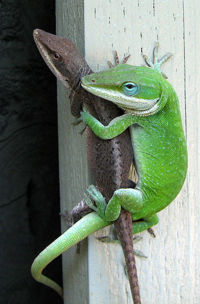| This article is still under construction. |
Lizards have breeding seasons determined by cycles of photoperiod, temperature, rainfall, and food availability. A corresponding fluctuation can be seen in male lizards and testicular size. Male lizards may also undergo behavioural changes during breeding season and become more territorial and aggressive.
Lizard reproductive strategies vary; they may be:
- oviparous - laying eggs
- ovoviviparous - the eggs are retained within the female until birth of live young
- viviparous - live-bearing, with a placental type of circulatory connection
- parthenogenic - asexual reproduction found in lizards such as certain Lacerta spp. and whiptail lizards (Aspidocelis [Cnemidophorus] spp.) consisting entirely of females. Although they reproduce asexually, these females still show courting and pseudocopulation.
Parthenogenesis has been reported in about 30 species of lizards.
Sexual Maturity
Sexual maturity in reptiles is mainly determined by size. Standard ages of sexual maturity found in the literature usually apply to free-ranging animals. However in captiivty, environmental conditions, care and most importantly diet vary dramatically, resulting in reptiles becoming sexually mature at very different ages. As a reference and rough generality, small lizards take 1 to 2 years and large lizards 3 to 4 years to reach sexual maturity.
Follicle and Egg Development
References
- Mader, D.R. (2005). Reptile Medicine and Surgery. Saunders. pp. 1264. ISBN 072169327X
